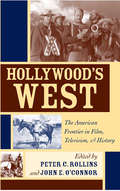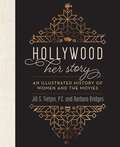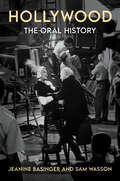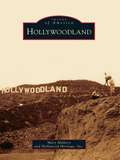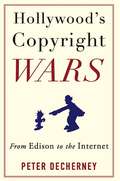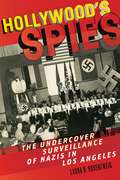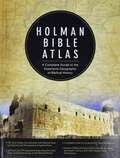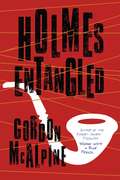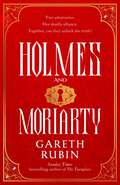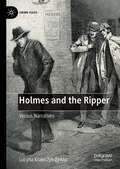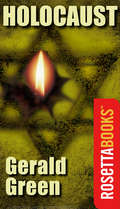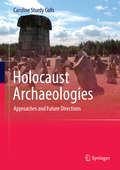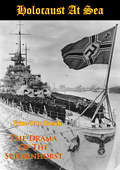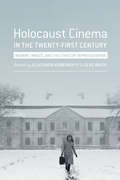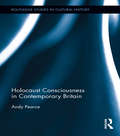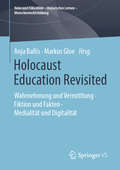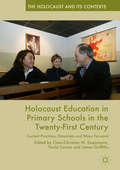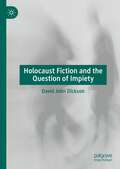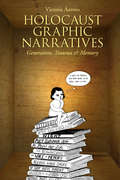- Table View
- List View
Hollywood's West: The American Frontier in Film, Television, & History
by Peter C. Rollins and John E. O’Connor&“An excellent study that should interest film buffs, academics, and non-academics alike&” (Journal of the West). Hollywood&’s West examines popular perceptions of the frontier as a defining feature of American identity and history. Seventeen essays by prominent film scholars illuminate the allure of life on the edge of civilization and analyze how this region has been represented on big and small screens. Differing characterizations of the frontier in modern popular culture reveal numerous truths about American consciousness and provide insights into many classic Western films and television programs, from RKO&’s 1931 classic Cimarron to Turner Network Television&’s recent made-for-TV movies. Covering topics such as the portrayal of race, women, myth, and nostalgia, Hollywood&’s West makes a significant contribution to the understanding of how Westerns have shaped our nation&’s opinions and beliefs—often using the frontier as metaphor for contemporary issues.
Hollywood's White House: The American Presidency in Film and History
by Peter C. Rollins and John E. O’ConnorFrom action flicks to biopics to SNL skits, how presidents are portrayed on screen: &“An interesting study of the real presidency and the reel presidency.&” —USA Today Magazine Winner of the Popular Culture Association&’s Ray and Pat Browne Book Award Whether serious or satirical, biographical or fictional, the ways that US presidents are depicted in popular culture reveal much about us as a nation. The contributors to Hollywood&’s White House examine the historical accuracy of presidential depictions, illuminate their influence, and uncover how they reflect the concerns of their times and the social and political visions of the filmmakers. With reflections on portrayals of Washington, Adams, Lincoln, FDR, Nixon, and more, this volume, which includes a comprehensive filmography and a bibliography, is ideal for both historians and film enthusiasts. &“An engaging collection.&” —Robert Brent Toplin, author of Reel History: In Defense of Hollywood
Hollywood: Her Story, An Illustrated History of Women and the Movies
by Jill Tietjen Barbara BridgesThe year was 1896, the woman was Alice Guy-Blaché, and the film was The Cabbage Fairy. It was less than a minute long. Guy-Blaché, the first female director, made hundreds of movies during her career. Thousands of women with passion and commitment to storytelling followed in her footsteps. Working in all aspects of the movie industry, they collaborated with others to create memorable images on the screen. This book pays tribute to the spirit, ambition, grit and talent of these filmmakers and artists.With more than 1200 women featured in the book, you will find names that everyone knows and loves—the movie legends. But you will also discover hundreds and hundreds of women whose names are unknown to you: actresses, directors, stuntwomen, screenwriters, composers, animators, editors, producers, cinematographers and on and on. Stunning photographs capture and document the women who worked their magic in the movie business.Perfect for anyone who enjoys the movies, this photo-treasury of women and film is not to be missed.
Hollywood: Number 5 in series (Narratives of empire)
by Gore VidalContinuing what has been dubbed his 'revenge on two hundred years of American history', Gore Vidal locates this novel in Washington. But this is 1917, and Hollywood is now competing with America's capital as the nation's power-base, just as it fights for centre-stage in this book. Caroline Sanford, erstwhile newspaper magnate, launches herself into the West Coast land of celluloid dreams and becomes, overnight, an international star. Not for nothing, on the dawn of World War One, is Caroline making films like the Huns from Hell. She is a government agent. But in Washington, that government isn't doing awfully well. Weighed down by his League of Nation's failure, by Roosevelt, Clemenceau, a stroke and the ship-like tonnage of his wife Edith, President Woodrow Wilson is on the wane - and Warren Harding is on the up. A popular, handsome, toothpick-chomping philanderer and dimwit whose wife is given to consulting spiritualists, he is about to usher in a new era. One of unprecedented scandal, cinematic extravagance and tawdry disintegration. The sort of era where the President could easily be mistaken for a film star ...
Hollywood: The Oral History
by Jeanine Basinger Sam WassonThe real story of Hollywood as told by such luminaries as Steven Spielberg, Frank Capra, Katharine Hepburn, Meryl Streep, Harold Lloyd, and nearly four hundred others, assembled from the American Film Institute’s treasure trove of interviews, reveals a fresh history of the American movie industry from its beginnings to today. From the archives of the American Film Institute comes a unique picture of what it was like to work in Hollywood from its beginnings to its present day. Gleaned from nearly three thousand interviews, involving four hundred voices from the industry, Hollywood: The Oral History, lets a reader “listen in” on candid remarks from the biggest names in front of the camera—Bette Davis, Meryl Streep, Tom Hanks, Harold Lloyd—to the biggest behind it—Frank Capra, Steven Spielberg, Alfred Hitchcock, Jordan Peele, as well as the lesser known individuals that shaped what was heard and seen on screen: musicians, costumers, art directors, cinematographers, writers, sound men, editors, make-up artists, and even script timers, messengers, and publicists. The result is like a conversation among the gods and goddesses of film: lively, funny, insightful, historically accurate and, for the first time, authentically honest in its portrait of Hollywood. It’s the insider’s story. Legendary film scholar Jeanine Basinger and New York Times bestselling author Sam Wasson, both acclaimed storytellers in their own right, have undertaken the monumental task of digesting these tens of thousands of hours of talk and weaving it into a definitive portrait of workaday Hollywood.
Hollywoodland
by Hollywood Heritage Inc. Mary MalloryEstablished by real estate developers Tracy E. Shoults and S. H. Woodruff in 1923, Hollywoodland was one of the first hillside developments built in Hollywood. Touting its class and sophistication, the neighborhood promoted a European influence, featuring such unique elements as stone retaining walls and stairways, along with elegant Spanish, Mediterranean, French Normandy, and English Tudor styled homes thoughtfully placed onto the hillsides. The community contains one of the world's most recognizable landmarks, the Hollywood sign, originally constructed as a giant billboard for the development and reading "Hollywoodland." The book illustrates the development of the upper section of Beachwood Canyon known as Hollywoodland with historic photographs from Hollywood Heritage's S. H. Woodruff Collection as well as from other archives, institutions, and individuals.
Hollywood’s Copyright Wars: From Edison to the Internet (Film and Culture Series)
by Peter DecherneyCopyright law is important to every stage of media production and reception. It helps determine filmmakers' artistic decisions, Hollywood's corporate structure, and the varieties of media consumption. The rise of digital media and the internet has only expanded copyright's reach. Everyone from producers and sceenwriters to amateur video makers, file sharers, and internet entrepreneurs has a stake in the history and future of piracy, copy protection, and the public domain. Beginning with Thomas Edison's aggressive copyright disputes and concluding with recent lawsuits against YouTube, Hollywood's Copyright Wars follows the struggle of the film, television, and digital media industries to influence and adapt to copyright law. Many of Hollywood's most valued treasures, from Modern Times (1936) to Star Wars (1977), cannot be fully understood without appreciating their legal controversies. Peter Decherney shows that the history of intellectual property in Hollywood has not always mirrored the evolution of the law. Many landmark decisions have barely changed the industry's behavior, while some quieter policies have had revolutionary effects. His most remarkable contributions uncover Hollywood's reliance on self-regulation. Rather than involve congress, judges, or juries in settling copyright disputes, studio heads and filmmakers have often kept such arguments "in house," turning to talent guilds and other groups for solutions. Whether the issue has been battling piracy in the 1900s, controlling the threat of home video, or managing modern amateur and noncommercial uses of protected content, much of Hollywood's engagement with the law has occurred offstage, in the larger theater of copyright. Decherney's unique history recounts these extralegal solutions and their impact on American media and culture.
Hollywood’s South Seas and the Pacific War
by Chris Dixon Sean BrawleyThis book explores the expectations, experiences, and reactions of Allied servicemen and women who served in the wartime Pacific and viewed the South Pacific through the lens of Hollywood's South Seas. Based on extensive archival research, it explores the intersections between military experiences and cultural history.
Hollywood’s Spies: The Undercover Surveillance of Nazis in Los Angeles (Goldstein-Goren Series in American Jewish History #11)
by Laura B RosenzweigThe remarkable story of the Jewish moguls in Hollywood who established the first anti-Nazi Jewish resistance organization in the country in the 1930s.Finalist, Celebrate 350 Award in American Jewish Studies The 1939 film Confessions of a Nazi Spy may have been the first cinematic shot fired by Hollywood against Nazis in America, but it by no means marked the political awakening of the film industry&’s Jewish executives to the problem. Hollywood&’s Spies tells the remarkable story of the Jewish moguls in Hollywood who paid private investigators to infiltrate Nazi groups operating in Los Angeles, establishing the first anti-Nazi Jewish resistance organization in the country—the Los Angeles Jewish Community Committee (LAJCC). Drawing on more than 15,000 pages of archival documents, Laura B. Rosenzweig offers a compelling narrative illuminating the role that Jewish Americans played in combating insurgent Nazism in the United States in the 1930s. Forced undercover by the anti-Semitic climate of the decade, the LAJCC partnered with organizations whose Americanism was unimpeachable, such as the American Legion, to channel information regarding seditious Nazi plots to Congress, the Justice Department, the FBI and the Los Angeles Police Department.Hollywood&’s Spies corrects the decades-long belief that American Jews lacked the political organization and leadership to assert their political interests during this period in our history and reveals that the LAJCC was one of many covert &“fact finding&” operations funded by Jewish Americans designed to root out Nazism in the United States. &“A remarkable tale.&” —The Wall Street Journal &“Expose[s] a buried story about underground plots waged by Nazis against major Hollywood figures.&” —Los Angeles Review of Books
Holman Bible Atlas: A Complete Guide To The Expansive Geography Of Biblical History
by Thomas V. BriscoWinner of the ECPA Gold Medallion Book Award, the Holman Bible Atlas is the leading Bible atlas in the English language. Through the use of 132 full-color maps, more than 100 color photographs, timelines, chart summaries, and helpful sidebars, it places readers in the geographical, historical, and cultural contexts of the Bible and enables them to experience its perennially relevant message. The book is presented in two broad divisions: physical geography of the Ancient Near East and biblical history periods from the patriarchs to the Christian era until Constantine. The content is arranged in line with specific biblical texts so that teachers, pastors, and students will see the key events of the Bible and Christianity with exceptional clarity. There’s also a wealth of written and visual information regarding various people groups (Aramaeans, Moabites, Phoenicians, etc.), great empires (Egypt, Babylonia, Rome, etc.), and the road systems, agricultural year, and economic life of ancient civilizations based on archaeological recoveries.
Holman Hunt and the Light of the World in Oxford (Routledge Studies in Theology, Imagination and the Arts)
by Markus BockmuehlThis book provides an up-to-date introduction to the religious and artistic story behind The Light of the World by William Holman Hunt. Created in the mid-nineteenth century, it is often said to be the most widely exhibited work of art in history and remains one of the most widely known Christian paintings to this day. The subject matter provides a rich wealth of resources, touching on the extraordinary artistic renewal associated with the Oxford Movement, its religious and intellectual revolution in recovering early Christian tropes and motives of scriptural interpretation. The book also considers the painting’s impact on the religious and cultural life of the British Empire as its tour served not just spiritual edification but also the promotion of imperial values. The contributions reflect on concerns of decolonisation while illustrating religious art’s ability to engage relevantly with contemporary concerns. Enabling a fresh encounter with the painting, this book will be of interest to theologians, biblical scholars, and historians.
Holmes Entangled
by Gordon McAlpineFrom the Edgar®-nominated author of Hammett Unwritten and Woman with a Blue Pencil comes a startling meta-fiction tale told in the voice of Sherlock Holmes. Set in 1920s' London, Cambridge, and Paris, Holmes's final adventure leads him through labyrinths of crime and espionage in a mortally dangerous inquiry into the unseen nature of existence itself. Sherlock Holmes, now in his seventies, retired from investigations and peaceably disguised as a professor at Cambridge, is shaken when a modestly successful author in his late-sixties named Arthur Conan Doyle calls upon him at the university. This Conan Doyle, notable for historical adventure stories, science fiction, and a three-volume history of the Boer War (but no detective tales), somehow knows of the false professor's true identity and pleads for investigative assistance. Someone is trying to kill Conan Doyle. Who? Why? Good questions, but what intrigues Holmes most is how the "middling scribbler" ascertained Holmes's identity in the first place, despite the detective's perfect disguise. Holmes takes the case.There is danger every step of the way. Great powers want the investigation quashed. But with the assistance of Dr. Watson's widow, Holmes persists, exploring séances, the esoterica of Edgar Allan Poe, the revolutionary new science of quantum mechanics, and his own long-denied sense of loss and solitude. Ultimately, even Sherlock Holmes is unprepared for what the evidence suggests.
Holmes and Moriarty
by Gareth RubinThis immersive, clever, and twisty Sherlock Holmes mystery adventure by the author of the acclaimed novel Turnglass pairs Holmes and Watson with two very unlikely allies—Moriarty and his trusted second, Moran—to solve a sinister plot that could threaten the very existence of the human race as we know it. Sherlock Holmes and Dr. John Watson have been hired by theater actor George Reynolds to find out why the audience who comes to see him perform onstage every night are the same people—only wearing different disguises each time. Is something sinister going on and, if so, what? Meanwhile, Holmes&’s archenemy, Professor James Moriarty, is having problems of his own. Implicated in a rival gang leader&’s murder, Moriarty and his second, Moran, must go on the run from the police as they try to find out who&’s behind the frame-up. But their investigation puts them in the way of Holmes and Watson and it&’s not long before all four realize they&’re being targeted by the same person. With million of lives on the line, Holmes and Moriarty must form an uneasy alliance in order to unmask the true villain.For fans of Anthony Horowitz's The House of Silk and Moriarty, this is the first Sherlock Holmes book endorsed by the Conan Doyle Estate in over a decade.
Holmes and Moriarty: The new official Sherlock Holmes novel
by Gareth RubinPreorder The Waterfall, the brand new Gareth Rubin novel, coming Autumn 2025.THE CLEVER AND INTRIGUING CRIME MYSTERY FROM THE AUTHOR OF THE INSTANT TOP TEN SUNDAY TIMES BESTSELLER, THE TURNGLASS.A new Sherlock Holmes novel, endorsed by the Conan Doyle Estate. 'A wonderfully entertaining, high-speed, high-stakes adventure with two, no FOUR and more, characters from classic detective fiction! Holmes and Moriarty by Gareth Rubin is the real deal: an accomplished tribute, true to the spirit of Conan-Doyle, but with a thrillingly original story and enough accomplished inventiveness to captivate and satisfy. The perfect fix for Holmes fans - thoroughly recommended!' Janice HallettTwo adversaries. One deadly alliance. Together, can they unlock the truth? Sherlock Holmes and his faithful friend, Dr John Watson, have been hired by actor George Reynolds to help him solve a puzzle. George wants them to find out why the audience who comes to see him perform every night are the same people, only wearing disguises. Is something sinister going on and, if so, what? Meanwhile, Holmes&’ archenemy, Professor James Moriarty is having problems of his own. Implicated in the murder of a gang leader, Moriarty and his second, Moran, must go on the run from the police in order to find out who is behind the set-up. But their investigation puts them in the way of Holmes and Watson and it&’s not long before all four realise that they are being targeted by the same person. With lives on the line, not just their own, they must form an uneasy alliance in order to unmask the true villain. With clues leading them to a hotel in Switzerland and a conspiracy far greater than any of them expected, who can be trusted – and will anyone of them survive? 'Beautifully written and perfectly capturing the Holmesian spirit. And, yes, sometimes I side with Prof. Moriarty, and I don't care who knows it. Love an evil genius . . .' Vaseem Khan 'Holmes and Moriarty is a rip-roaring thriller, fast-paced and twisty as the greatest detective and the greatest criminal become unlikely allies against the most formidable foes' Martin EdwardsPraise for The Turnglass: 'A bold, breathtaking piece of writing that absolutely nails its two books in one conceit. I doubt I'll ever read anything like it again, which is the highest compliment I can offer' Stuart Turton 'A stunning, ingenious, truly immersive mystery. The Turnglass is a thrilling delight' Chris Whitaker 'An intricate and thoroughly mesmerising tale of family plots and schemes across several generations' Guardian
Holmes and the Ripper: Versus Narratives (Crime Files)
by Lucyna Krawczyk-ŻywkoIn versus narratives Sherlock Holmes is fighting or otherwise engaging Jack the Ripper. These texts pit the archetypal detective against the archetypal serial killer using established formulas as well as new narrative and generic features, a combination that results in their mass appeal among authors and audiences alike. The list of primary sources includes 120 titles – novels, short stories, plays, fanfiction, ‘Grand Game’ studies, movies, TV shows, video and board games – which are treated as a dialogic network of transfictional and transmedial texts. This study unpacks the versus corpus in its media dispersal by analysing Sherlock Holmes and Jack the Ripper as serial figures and culture-texts emphasising the increasing palimpsestousness of the former and the multidirectional polymorphousness of the latter, and tracing the overlapping Doylean culture-text. It also addresses the way character constellations are represented, negotiated, and fed back into the versus network, contextualising them within the coalescence of fact and fiction, Gothic and crime fiction frames, cultural memory, neo-Victorianism, and biofiction.
Holocaust
by Gerald GreenThe epic novel of two families and the genocide in Nazi Germany, by the writer of the blockbuster TV miniseries. The Dorfs are &“good&” Germans, loyal to the new Nazi regime, with whom their son Erik, a promising lawyer, finds his ambitions realized with the SS at the side of the ruthless Reinhard Heydrich. The Weisses are Jewish, also &“good&” Germans—but under the new regime, they are doomed. Told through the reminiscences of Erik Dorf, the ambitious SS officer, and the courageous young Jew Rudi Weiss, who ran away from his family as a young boy in an effort to fight the Nazis, this novel takes us through almost every significant event of the Third Reich, from the horrific reality of Kristallnacht to the mass exterminations at Auschwitz. It is a portrait of the extraordinary choices all Germans were forced to make on a daily basis—and the unimaginable consequences if they were wrong. A winner of the Dag Hammarskjöld International Prize, with more than two million copies sold, Holocaust is an unforgettable glimpse into this monumental human tragedy.
Holocaust Archaeologies
by Caroline Sturdy CollsHolocaust Archaeologies: Approaches and Future Directions aims to move archaeological research concerning the Holocaust forward through a discussion of the variety of the political, social, ethical and religious issues that surround investigations of this period and by considering how to address them. It considers the various reasons why archaeological investigations may take place and what issues will be brought to bear when fieldwork is suggested. It presents an interdisciplinary methodology in order to demonstrate how archaeology can (uniquely) contribute to the history of this period. Case examples are used throughout the book in order to contextualise prevalent themes and a variety of geographically and typologically diverse sites throughout Europe are discussed. This book challenges many of the widely held perceptions concerning the Holocaust, including the idea that it was solely an Eastern European phenomena centred on Auschwitz and the belief that other sites connected to it were largely destroyed or are well-known. The typologically , temporally and spatial diverse body of physical evidence pertaining to this period is presented and future possibilities for investigation of it are discussed. Finally, the volume concludes by discussing issues relating to the "re-presentation" of the Holocaust and the impact of this on commemoration, heritage management and education. This discussion is a timely one as we enter an age without survivors and questions are raised about how to educate future generations about these events in their absence.
Holocaust At Sea: The Drama Of The Scharnhorst
by Fritz-Otto BuschOn Christmas Day, 1943, blinded by the fury of an Arctic blizzard, encircled by enemy destroyers, the German battleship Scharnhorst fought for her life.The luck of the Scharnhorst had become a legend. In 1942 she had slipped unscathed through the Channel under the very bows of the British fleet to harry the Arctic convoy-routes. The British convoy which sailed for Murmansk on Christmas Eve, 1943, seemed a perfect target for another lightning raid. In fact it was a trap to lure the battleship into the open and then destroy her.This is the story of the Scharnhorst’s dramatic sortie from her Norwegian lair.The story of a battle fought with outstanding courage against impossible odds until the most feared of all Hitler’s battleships sank at last off North Cape.
Holocaust Cinema in the Twenty-First Century
by Oleksandr Kobrynskyy Gerd BayerIn the first fifteen years of the twenty-first century, a large number of films were produced in Europe, Israel, the United States, and elsewhere addressing the historical reality and the legacy of the Holocaust. Contemporary Holocaust cinema exists at the intersection of national cultural traditions, aesthetic conventions, and the inner logic of popular forms of entertainment. It also reacts to developments in both fiction and documentary films following the innovations of a postmodern aesthetic. With the number of witnesses to the atrocities of Nazi Germany dwindling, medialized representations of the Holocaust take on greater cultural significance. At the same time, visual responses to the task of keeping memories alive have to readjust their value systems and reconsider their artistic choices. Both established directors and a new generation of filmmakers have tackled the ethically difficult task of finding a visual language to represent the past that is also relatable to viewers. Both geographical and spatial principles of Holocaust memory are frequently addressed in original ways. Another development concentrates on perpetrator figures, adding questions related to guilt and memory. Covering such diverse topics, this volume brings together scholars from cultural studies, literary studies, and film studies. Their analyses of twenty-first-century Holocaust films venture across national and linguistic boundaries and make visible various formal and intertextual relationships within the substantial body of Holocaust cinema.
Holocaust Cinema in the Twenty-First Century: Images, Memory, and the Ethics of Representation
by Bayer Gerd Kobrynskyy OleksandrIn the first fifteen years of the twenty-first century, a large number of films were produced in Europe, Israel, the United States, and elsewhere addressing the historical reality and the legacy of the Holocaust. Contemporary Holocaust cinema exists at the intersection of national cultural traditions, aesthetic conventions, and the inner logic of popular forms of entertainment. It also reacts to developments in both fiction and documentary films following the innovations of a postmodern aesthetic. With the number of witnesses to the atrocities of Nazi Germany dwindling, medialized representations of the Holocaust take on greater cultural significance. At the same time, visual responses to the task of keeping memories alive have to readjust their value systems and reconsider their artistic choices.Both established directors and a new generation of filmmakers have tackled the ethically difficult task of finding a visual language to represent the past that is also relatable to viewers. Both geographical and spatial principles of Holocaust memory are frequently addressed in original ways. Another development concentrates on perpetrator figures, adding questions related to guilt and memory. Covering such diverse topics, this volume brings together scholars from cultural studies, literary studies, and film studies. Their analyses of twenty-first-century Holocaust films venture across national and linguistic boundaries and make visible various formal and intertextual relationships within the substantial body of Holocaust cinema.
Holocaust Consciousness in Contemporary Britain (Routledge Studies in Cultural History #27)
by Andy PearceThe Holocaust is a pervasive presence in British culture and society. Schools have been legally required to deliver Holocaust education, the government helps to fund student visits to Auschwitz, the Imperial War Museum's permanent Holocaust Exhibition has attracted millions of visitors, and Britain has an annually commemorated Holocaust Memorial Day. What has prompted this development, how has it unfolded, and why has it happened now? How does it relate to Britain's post-war history, its contemporary concerns, and the wider "globalisation" of Holocaust memory? What are the multiple shapes that British Holocaust consciousness assumes and the consequences of their rapid emergence? Why have the so-called "lessons" of the Holocaust enjoyed such popularity in Britain? Through analysis of changing engagements with the Holocaust in political, cultural and memorial landscapes over the past generation, this book addresses these questions, demonstrating the complexities of Holocaust consciousness and reflecting on the contrasting ways that history is used in Britain today.
Holocaust Education Revisited: Wahrnehmung und Vermittlung • Fiktion und Fakten • Medialität und Digitalität (Holocaust Education – Historisches Lernen – Menschenrechtsbildung)
by Markus Gloe Anja BallisDer Band wendet sich Konzepten von „Holocaust Education“ zu, die auf einer Tagung an der LMU München im Februar 2018 diskutiert worden sind: Wissenschaftlerinnen und Wissenschaftler verschiedener Disziplinen reflektierten über Zieldimensionen, mediale Repräsentationen sowie Wandel und Herausforderungen bei der Vermittlung der Themenfelder Holocaust und NS-Verbrechen. Die kritische Auseinandersetzung mit Konzepten von „Holocaust Education“ hat sich auch im 21. Jahrhundert als produktiv erwiesen: Es kann ein vielstimmiger und auf die Gegenwart bezogener Diskurs entfaltet werden, der von Fragen der Vermittlung im Klassenzimmer bis zu der Virtualisierung von Zeugenschaft in Museen und daraus resultierender didaktischer Konsequenzen reicht. Der InhaltZur Einführung • Wahrnehmung und Vermittlung • Fiktionen und Fakten • Medialität und DigitalitätDie HerausgeberDr. Anja Ballis ist Professorin am Fachbereich Didaktik der deutschen Sprache und Literatur der Ludwig-Maximilians-Universität München.Dr. Markus Gloe ist Professor am Fachbereich Politische Bildung und Didaktik der Sozialkunde an der Ludwig-Maximilians-Universität München.
Holocaust Education in Primary Schools in the Twenty-First Century: Current Practices, Potentials and Ways Forward (The Holocaust and its Contexts)
by Paula Cowan Claus-Christian W. Szejnmann James GriffithsThis collection is the first of its kind, bringing together Holocaust educational researchers as well as school and museum educators from across the globe, to discuss the potentials of Holocaust education in relation to primary school children. Its contributors are from countries that have a unique relationship with the Holocaust, such as Germany, Israel, neutral Switzerland, and Allied countries outside the UK. Their research provides new insight into the diverse ways in which primary aged students engage with Holocaust education. Chapters explore the impact of teaching the Holocaust to this age group, school and museum teaching pedagogies, and primary students’ perspectives of the Holocaust. This book will appeal to school and museum educators of primary aged students whose work requires them to teach the Holocaust, Citizenship (or Civics) or Human Rights Education. Since the turn of the twenty-first century there has been a transformation in school and museum-based Holocaust education. This book clearly demonstrates that primary education has been included in this transformation.
Holocaust Fiction and the Question of Impiety
by David John DicksonThis book discusses the issues underlying contemporary Holocaust fiction. Using Gillian Rose’s theory of Holocaust piety, it argues that, rather than enhancing our understanding of the Holocaust, contemporary fiction has instead become overly focused on gratuitous representations of bodies in pain. The book begins by discussing the locations and imagery which have come to define our understanding of the Holocaust, before then highlighting how this gradual simplification has led to an increasing sense of emotional distance from the historical past. Holocaust fiction, the book argues, attempts to close this emotional and temporal distance by creating an emotional connection to bodies in pain. Using different concepts relating to embodied experience – from Sonia Kruks’ notion of feeling-with to Alison Landsberg’s prosthetic memory – the book analyses several key examples of Holocaust literature and film to establish whether fiction still possesses the capacity to approach the Holocaust impiously.
Holocaust Graphic Narratives: Generation, Trauma, and Memory
by Victoria AaronsIn Holocaust Graphic Narratives, Victoria Aarons demonstrates the range and fluidity of this richly figured genre. Employing memory as her controlling trope, Aarons analyzes the work of the graphic novelists and illustrators, making clear how they extend the traumatic narrative of the Holocaust into the present and, in doing so, give voice to survival in the wake of unrecoverable loss. In recreating moments of traumatic rupture, dislocation, and disequilibrium, these graphic narratives contribute to the evolving field of Holocaust representation and establish a new canon of visual memory. The intergenerational dialogue established by Aarons’ reading of these narratives speaks to the on-going obligation to bear witness to the Holocaust. Examined together, these intergenerational works bridge the erosions created by time and distance. As a genre of witnessing, these graphic stories, in retracing the traumatic tracks of memory, inscribe the weight of history on generations that follow.
